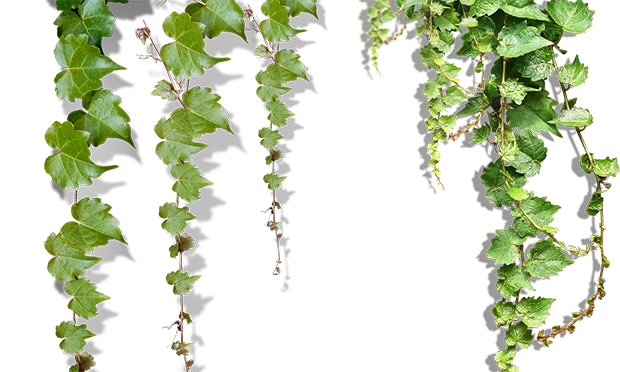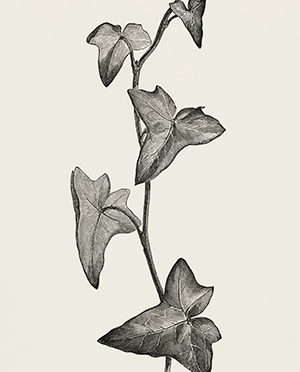The Citizen Gardener: Ivy

Gardening is a world not untouched by trends, and there has been one plant at the bottom of the fashion rung for too many years: ivy.
We deride it as invasive, unsightly and a harborer of snails and slugs, but when we consider ivy’s qualities – infinitely variable, pollution-cleansing, tough and brilliant for wildlife and people alike – these undemanding evergreens would seem to be ripe and ready for a return to glory. And with over 400(!) cultivars to choose from, there is something for everyone. Ivy is back – you heard it here first.
Perhaps one of the reasons it has fallen out of favour is because of its reputation as old-fashioned. But at what point does something go from old-fashioned to classic? With its storied and significant European past, I would argue that ivy falls into the latter group.
Ivy has been a central character in European plant culture for a long time. In ancient Rome, it was a symbol of intellectual achievement and wreaths were woven to crown winners of poetry and athletics contests.
Early herbalists believed ivy’s berries could help with a hangover.
Britons made ale-poles out of a branch covered in ivy leaves, to indicate premises where ale and wine was sold.
The Victorians would train ivy up buildings and fill their greenhouses with different varieties. Indeed, Queen Victoria herself wore a wreath of Osborne ivy intertwined with diamonds in her hair.
Our en-vogue modern day equivalent to an ivy-covered wall is the ‘living wall’, which in my opinion is well overdue a fall from grace.
Every time I walk past another complex watering system being installed with scores of workers on cranes hauling huge panels, I think to myself, ‘None of this is necessary!’
Ivy is a cheaper, easier and more effective option, without the resource-heavy costs of installation and maintenance that its new-fangled equivalent requires, and with more environmental benefits to boot.
One such benefit is ivy’s proven ability to cool buildings in warm weather, both passively by shading its surface from the sun’s rays and actively by the loss of heat as water evaporates from their leaves. According to some studies, this can be as much as 28 per cent on a west-facing wall on a hot summer’s day.

Illustration from The Ivy: A Monograph by Shirley Hibberd
What’s more, evergreen climbers can have the opposite effect in winter, acting as an insulating layer preventing loss of heat from the building. In one study, temperatures on an ivy-clad wall were 3C warmer in winter and 3C cooler in summer compared to bare brickwork. It’s a small difference that can have a big impact on energy use.
Climbers like ivy also capture tiny particulates from the air that have been associated with a wide range of health problems, and constantly draw carbon dioxide from the air around them by photosynthesis.
There is also the simple but important fact that a view of a leafy green tapestry beats bare bricks every time.
We now know that healing times in hospitals can be shorter for patients looking out at green views than for those looking out on brick walls.
Exercising in green spaces not only feels easier, but can even burn more calories per session, for a range of complex reasons we are yet to fully understand.
In a densely populated urban environment like Hackney, where space is at a premium, greening vertical surfaces is a canny way of adding enormous amounts of nature without taking up any extra land footprint.
One reason why this simple solution is not taken up by more homeowners and property managers is the fear of damaging brickwork. But contrary to popular belief, studies suggest that sound masonry is unaffected by these plants, whose aerial roots only penetrate existing cracks.
In fact, if the wall is well maintained, the insulating effect of the foliage from the freeze and thaw cycle can protect it from damage. Likewise, the dense leaf cover and water-absorbing aerial roots of climbers may help keep walls marginally drier, despite being popularly thought of as a cause of damp.
The main issue keen, green homeowners may run into is in preventing the vigorous new growth of ivy from choking drains and guttering and damaging paint finishes. Fortunately, recent research has shown that simply using an anti-graffiti paint is effective in preventing the aerial roots from attaching to brickwork, meaning it is cheap and easy to paint on buffer zones to confine plant growth to exactly where you want it.
I am not advocating a garden full of the stuff, but a little goes a long way. And there’s a much wider world than the straight Hedera helix (English Ivy): there are pretty ones (H. helix ‘Glacier’), wavy-edged ones (‘Ivalace’ or ‘Parsley Crested’), rampant ivies (H. colchica ‘Sulphur Heart’ or ‘Dentata Variegata’) and smaller, delicate ones (H. ‘Congesta’ or ‘Erecta’).
When it comes to the benefits to our local animal population though, it’s a case of the more ivy, the merrier the wildlife. Its evergreen, waxy foliage provides shelter for birds to nest and insects to hibernate, and it also provides food for caterpillars of the holly blue butterfly and the double-striped pug, swallow-tailed and yellow-barred brindle moths.
Ivy flowers in autumn when very little else is in bloom – take a walk around mature ivy in autumn and you’ll hear it before you see it: the buzz of bees, flies, wasps and hoverflies, plus the colourful flutter of the odd late-flying butterfly, are all testament to its popularity with pollinators, as is the heady scent of ivy wafting from the honeybee hives at St Mary’s Secret Garden over the past few months.
If you don’t have a wall for it to climb, there are a lot of other ways to play with this adaptable evergreen. Ivy can be trained into interesting shapes, tied along wires to create living sculptures or mimic the look of an espaliered tree. It can also be grown as a houseplant and thrive in a cool room with bright indirect sunlight.
As we approach the season of giving, why not take advantage of nature’s bounty and share your favourite ivy with someone. They are easy to propagate and make a free and fun present with no carbon footprint.
Simply place sections of stem with at least two leaves into well-drained potting medium and cover with a plastic bag. Keep in a bright place that’s out of direct sunlight and remove the bag once new growth is visible. And hey presto, you’re a gardening fashionista ahead of the trends and behind a greener world for us all.
Steph Goward is an ecological gardener and food grower. She is the postcode gardener for E5, a horticultural therapist at St Mary’s Secret Garden, and works with a number of gardening groups across Hackney. You can follow her at @steph_orla_gardens.
